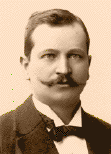| |

Home
Contact Info
Course Info
Calendar
Homework
Lecture Notes
|
|
|
|
PHY 251/420:
Introduction to Condensed Matter Physics
Prof. S. Teitel stte@pas.rochester.edu ---- Fall 2006
Problem Set 3
Due Monday, December 4, in lecture
- Problem 1 [15 points]
(Ashcroft & Mermin problem 4.1)
In each of the following cases indicate whether the structure is a Bravais lattice. If it is, give three primitive vectors; if it is not, describe it as a Bravais lattice with a small as possible a basis.
a) Base-centered cubic (simple cubic with additional points in the centers of the horizontal faces of the cubic cell).
b) Side-centered cubic (simple cubic with additional points in the centers of the vertical faces of the cubic cell).
c) Edge-centered cubic (simple cubic with additional points at the midpoints of the lines joining nearest neighbors).
- Problem 2 [20 points]
(Ashcroft & Mermin problem 4.6)
The face-centered cubic is the most dense and the simple cubic is the least dense of the three cubic Bravais lattices. The diamond structure is less dense than any of these One measure of this is that the coordination numbers are: fcc, 12; bcc, 8; sc, 6; diamond, 4. Another is the following: Suppose identical solid spheres are distributed through space in such a way that their centers lie on the points of each of these four structures, and spheres on neighboring points just touch, without overlapping. (Such an arrangement of spheres is called a close-packing arrangement.) Assuming that the spheres have unit density, show that the density of a set of close-packed spheres on each of the four structures (the "packing fraction") is:
| fcc: | sqrt(2)π/6 = 0.74 |
| bcc: | sqrt(3)π/8 = 0.68 |
| sc: | π/6 = 0.52 |
| diamond: | sqrt(3)π/16 = 0.34 |
- Problem 3 [15 points]
a) If a1, a2, a3 are the primitive vectors of a Bravais Lattice, show that the volume of a primitive cell is:
v = |a1·(a2×a3)|
b) Using the definition of the primitive vectors of the reciprocal lattice:
| b1 = 2π |
a2×a3
a1·(a2×a3) | , etc. |
show that:
| b1·(b2×b3) = |
(2π)3
a1·(a2×a3) |
and hence that the volume of a primitive cell of the reciprocal lattice is (2π)3/v.
c) The nth Brillouin Zone can be defined as that region of k-space which can be reached from the origin by crossing exactly n-1 Bragg planes and no more or less. Alternatively, the nth Brillouin Zone can be defined as the set of points in k-space that have the origin as their nth nearest reciprocal lattice point. Use this later definition to show that each Brillouin Zone is a primitive cell of the reciprocal lattice (Hint: consider the proof we gave that the Wigner-Seitz cell was a primitive cell of the Bravais lattice).
- Problem 4 [20 points]
(Ashcroft & Mermin problem 9.5, but a little easier!)
Consider a two-dimensional square lattice with lattice constant a.
a) Write down, in units of 2π/a, the radius of a circle that can accommodate m free electrons per primitive cell. Construct a table listing which of the first five Brillouin Zones of the square lattice (see A&M Figs. 9.7 and 9.15a) are completely full, which are partially empty, and which are completely empty for m = 1, 2, . . . , 7. Verify that if m ≤ 7, the occupied levels lie entirely within the first five Brillouin Zones, and that when m ≥ 8, levels in the sixth zone become occupied.
b) Draw pictures of all branches of the Fermi surface, translated back into the first Brillouin Zone, for the cases m = 1, 2, . . . , 5 (note, the example shown in A&M Fig. 9.15b is not in the first Brillouin Zone) and shade the regions corresponding to the occupied states.
|
|
